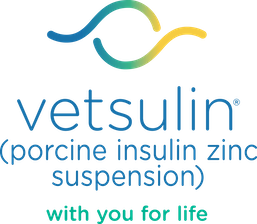

Glucose Toxicity and Hypoglycemia
Read More About Canine Diabetes
Glucose Toxicity
Glucose toxicity occurs when insulin secretion is reduced by prolonged hyperglycemia. Prolonged hyperglycemia can occur due to a number of causes. The prolonged and high-dose therapeutic use of glucocorticosteroids can induce diabetes mellitus. The use of exogenous progestogens can lead to growth hormone excess. Progestogens also have an affinity for glucocorticosteroid receptors.
Hypoglycemia in Canine Diabetes
If the insulin dose is too high, clinical signs of hypoglycemia may be observed. Hypoglycemia may also be triggered by events causing a relative insulin overdose:
- Loss of appetite
- Vomiting
- Excessive Exercise
The clinical signs of hypoglycemia, in increasing order of severity, are:
- Very quiet and inappetent
- Hunger
- Restlessness
- Shivering
- Ataxia
- Disorientation
- Convulsions and coma
Emergency Treatment of Hypoglycemia
- Immediate oral administration of glucose solution or corn syrup (1 g per kg body weight). Animals that are collapsed should not have large volumes of fluid forced into their mouths as this may result in aspiration pneumonia. Here it is preferable to rub a small amount of the glucose solution or corn syrup onto the animal’s gums or under its tongue.
- Intravenous dextrose solution (50%) can be administered in severe cases or if oral therapy has been ineffective. Dose for hypoglycemia 1–5 mL 50% dextrose by slow intravenous injection (over 10 minutes)7 — not aimed to correct blood glucose concentration but to reverse clinical signs.
Owners of pets with diabetes should always have a source of glucose readily available. Following the successful emergency administration of oral glucose, small amounts of food should be offered at intervals of 1–2 hours until the effects of the insulin overdose have been counteracted.
If the insulin dose is too high, it should be reduced, eg, by at least 10-50%. A follow up visit should be scheduled 1 week after dosage reduction to evaluation response to new dose.
Help Your Practice Manage Diabetes Mellitus
View and download resources and tools that will assist your hospital, inform your team, and help with clients.

Blood Glucose Curve Generator
Create a blood glucose curve to monitor and evaluate diabetes treatments.

Client Discharge Form
Create a customized, printable form for clients about their new diagnosis.

Diabetes Resources
Access online tools and more to support staff and pet parents.
No items to show.
Read More About Canine Diabetes
Important Safety Information:
Vetsulin® should not be used in dogs known to have a systemic allergy to pork or pork products. Vetsulin is contraindicated during periods of hypoglycemia. Keep out of reach of children. As with all insulin products, careful patient monitoring for hypoglycemia and hyperglycemia is essential to attain and maintain adequate glycemic control and prevent associated complications. Overdosage can result in profound hypoglycemia and death. The safety and effectiveness of Vetsulin in puppies, breeding, pregnant, and lactating dogs has not been evaluated. See package insert for full information regarding contraindications, warnings, and precautions.
References:
1. Martin GJ, Rand JS. Pharmacology of a 40 IU/ml porcine lente insulin preparation in diabetic cats: findings during the first week and after 5 or 9 weeks of therapy. J Feline Med Surg. 2001;3(1):23–30. 2. Vetsulin® (porcine insulin zinc suspension) [Freedom of Information Summary]. Millsboro, DE: Intervet Inc.; 2008. 3. Data on file, Merck Animal Health. 4. Graham PA, Nash AS, McKellar QA. Pharmacokinetics of porcine insulin zinc suspension in diabetic dogs. J Small Anim Pract. 1997;38(10):434–438. 5. Martin GJ, Rand JS. Pharmacokinetic and Pharmacodynamic Study of Caninsulin in Cats with Diabetes Mellitus. 2000: Internal Study Report. 6. Feldman EC, Nelson RW. Canine and Feline Endocrinology and Reproduction. 3rd ed. St. Louis, MO: Saunders; 2004:539–579. 7. Tennant B, ed. BSAVA Small Animal Formulary. 4th ed. Gloucestershire, UK: British Small Animal Veterinary Association; 2002. 8. Feldman EC, Nelson RW. Canine and Feline Endocrinology and Reproduction. 3rd ed. St. Louis, MO: Saunders; 2004:486–538. 9. Reusch C. Feline diabetes mellitus. In: Ettinger SJ, Feldman EC, eds. Textbook of Veterinary Internal Medicine. 7th ed. St. Louis, MO: Saunders; 2010:1796–1816. 10. Nelson RW. Canine diabetes mellitus. In: Ettinger SJ, Feldman EC, eds. Textbook of Veterinary Internal Medicine. 7th ed. St. Louis, MO: Saunders; 2010:1782–1796. 11. Burgaud S, Riant S, Piau N. Comparative laboratory evaluation of dose delivery using a veterinary insulin pen. In: Proceedings of the WSAVA/FECAVA/BSAVA congress; 12–15 April 2012; Birmingham, UK. Abstract 121. 12. Burgaud S, Guillot R, Harnois-Milon G. Clinical evaluation of a veterinary insulin pen in diabetic dogs. In: Proceedings of the WSAVA/ FECAVA/BSAVA congress; 12–15 April 2012; Birmingham, UK. Abstract 122. 13. Burgaud S, Guillot R, Harnois-Milon G. Clinical evaluation of a veterinary insulin pen in diabetic cats. In: Proceedings of the WSAVA/FECAVA/BSAVA congress; 12–15 April 2012; Birmingham, UK. Abstract 45. 14. Davison LJ, Walding B, Herrtage ME, Catchpole B. Anti-insulin antibodies in diabetic dogs before and after treatment with different insulin preparations. J Vet Intern Med. 2008;22:1317-1325. 15. Banfield State of Pet Health 2016 Report. p 12-13.
